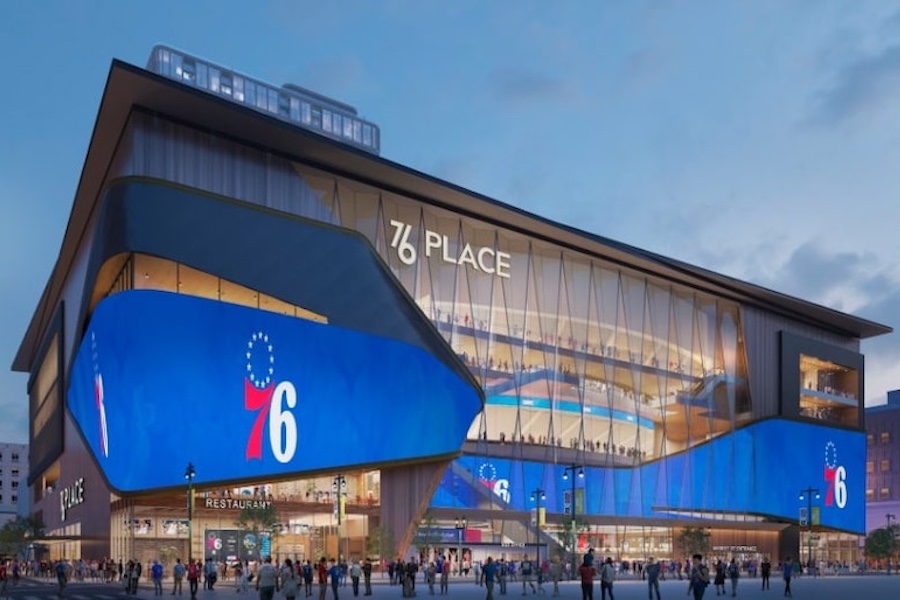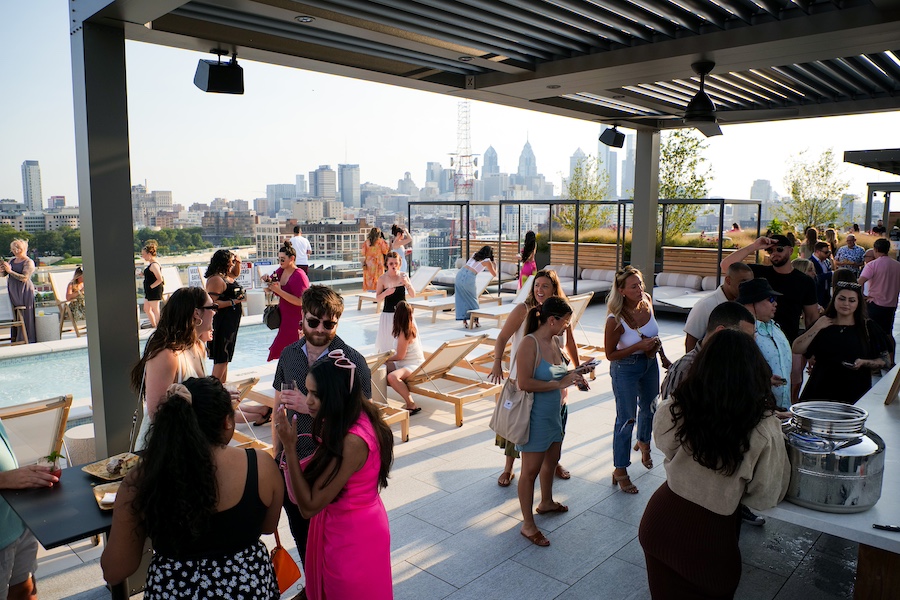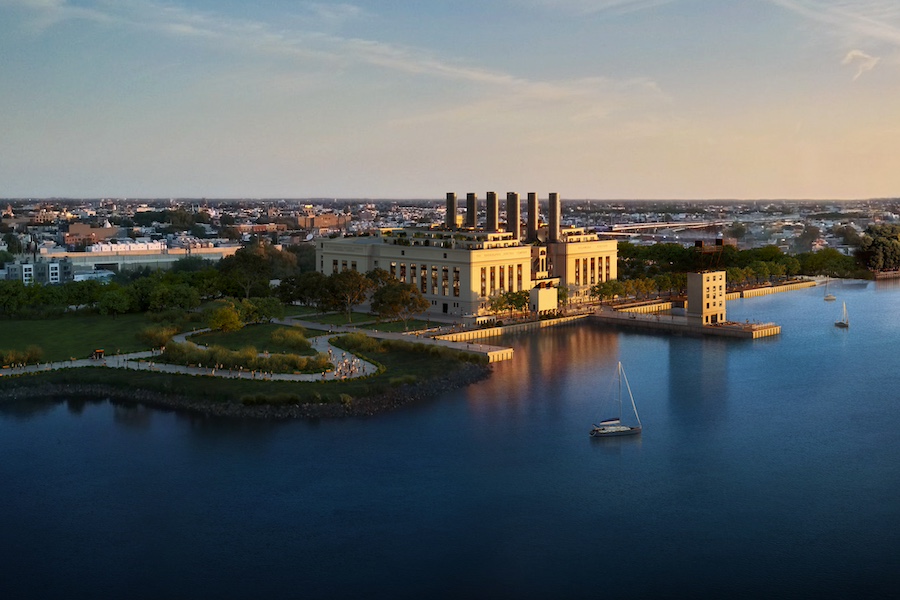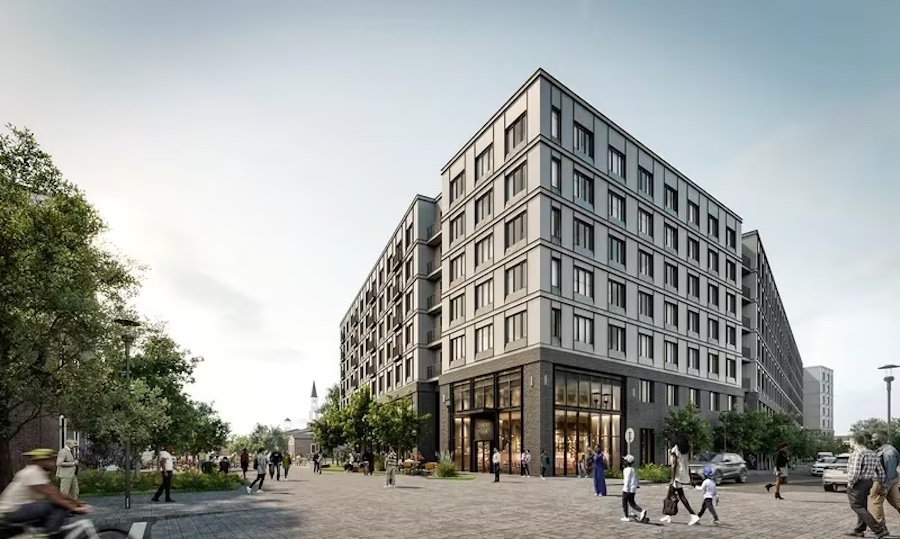The Top 5 Real Estate and Development Stories of 2023
An arena controversy grows, as does the supply of apartments, while home sales continue their slide but appear headed for a turnaround.

The design has been tweaked and features added to the 76 Place proposal since it was released last summer, but the changes haven’t silenced the critics. If anything, they’ve made them more numerous. / Rendering via 76 Devcorp
A cooling home sales market. A hot apartment sector. And a huge project in Center City that will have people talking for all of the years until ground is broken — assuming ground will be broken.
These are just a few of the stories that shaped and rocked the world of Philadelphia real estate this past year. Here are my picks for the five most important:
The 76ers’ proposed Center City arena draws increasing fire from critics on almost all sides
When 76ers co-owner David Adelman took the wraps off his team’s proposal to build a new arena in Center City last summer, some, including me, pronounced it a win-win. But organizations in Chinatown opposed it the moment the plans were unveiled, and in the year and a half since, their stance has gained more supporters.
As Laura Swartz explored in August, the stances and interests at play are complex, to say the least.
Meanwhile, as the Sixers continue to refine and tweak their original proposal — wait, it will include apartments! — the chorus of complaints continues to grow. Joining the Chinatowners in saying the arena will strangle their community are critics saying that, even with great transit access, everyone will drive to the arena still.
And this month, Philadelphia Inquirer architecture critic Inga Saffron traveled to Boston, whose TD Garden the Sixers hold up as an example of what they want to do here, and found some important differences between the two sites. Saffron has amplified the arguments of the critics with her megaphone.
And since there remain some loud proponents on the other side, including the building trade unions that helped put Cherelle Parker in 215 City Hall, we can expect this tug-of-war to last most of the two or more years it will likely take for this arena to get either greenlighted or derailed.

Photograph by Nora Carol Photography via Getty Images
Home sales continue their slide, but signs point to rising demand
Higher interest rates continue to depress home sales in the Greater Philadelphia region, but as this year comes to a close, signs point to a possible turnaround next year.
The most recent monthly figures in BHHS Fox & Roach Realtors’ HomExpert Market Report, which tracks all home sales in the 12-county Greater Philadelphia market, show that 9.7 percent fewer homes were sold this November than in 2022. But that figure represents an improvement over 2022’s market performance: Home sales that year were 34.8 percent off the 2021 pace.
But where homes sat on the market longer last year than they did in 2021, the homes that are selling now are selling faster than they did last year. Where average days on market rose from 28 in November 2021 to 30 last November — a rise of 7.1 percent — they fell by 10 percent this year, to 27. And sale prices accelerated their climb from last year: Where they rose five percent, from $366,958 to $385,485 in 2022, they rose 6.2 percent to $409,566.
And inventories continued a steady decline. Where they fell 9.1 percent from 2021 to 2022, they fell 8.9 percent from 2022 to this year. In addition, the number of properties that went under contract rose by 4.1 percent, a sharp reversal from last year’s 32 percent falloff. Those last figures suggest that, in contrast to last year, demand for housing is picking up once again across the region.
Agents I spoke with for this story report that the market has become bifurcated. Houses are flying off the shelves in the lower and middle markets but languishing in its upper reaches. As the Federal Reserve has signaled that it expects to cut interest rates next year, there’s a possibility that the upper end of the market might follow the lower end back to recovery.

The rooftop terrace at The Carson, one of the larger apartment buildings to open in the city this year / Photograph courtesy of Neff
An apartment construction boom leads to a supply glut
From Germantown in the northwest to the Navy Yard at the southern tip, apartment buildings have been sprouting like weeds this past year, continuing a trend that surfaced a year before. According to real estate data firm CoStar, more than 13,000 units were under construction in the city in 2023. In addition to the Battery in Fishtown, about which more below, other high-profile openings this year included Avira, the first residential building at Schuylkill Yards, and two new buildings in a clump of new projects on Spring Garden Street, the Carson and the Quincy.
Much of this new construction represents developers who rushed to get their projects okayed before the city’s 10-year property tax abatement for new residential construction was cut in half at the end of 2021. But the thousands of new apartments that have opened in the past two years has led to a glut of units on the market. This is proving good for renters, as all the new supply is pushing rent hikes back down to more normal levels and leading landlords to offer incentives such as months of free rent to fill vacant units.
But the surge in supply has now led some developers to hold off on starting other new multi-family buildings. A previously announced Bock Development project at the northwest corner of 11th and Walnut streets in Washington Square West, for instance, remains in a state of suspended animation after the Wendy’s restaurant on whose site it will rise was demolished, and plans for a 300-unit building at 12th and Race streets have been shelved. But there are still enough units in the pipeline that the chance of Philly becoming a majority-renter city, while slim, remains real.

Rendering of the Battery / Rendering courtesy of the Battery
A landmark reclaimed on the Delaware waterfront …
Meanwhile, the pace of residential development continues to quicken along Philly’s riverfront.
Northbank, the 900-unit new townhouse project in Port Richmond that’s enering its third phase, got a downstream neighbor this fall when the Battery opened its doors in Fishtown. This mixed-use project has transformed a century-old PECO generating station into 173 apartments, a 62-room hotel operated by the Rivers Casino, a 25,000-square foot catering and event facility and a mix of office spaces from co-working to private office suites. The development also completes a missing link in the Delaware River hiking and biking trail, part of the East Coast Greenway.
Lubert-Adler Real Estate Funds vice president Leonard Klehr said in October, “The location of the property on the Delaware is objectively part of Fishtown, but Philadelphians don’t think of it as in Fishtown because there’s nothing going on there. But we hope that with this development, we will effectively bring Fishtown to the river.”

Rendering of the AVE Normandy and Constitution buildings by DIGSAU
… while work gets under way on the Navy Yard’s first residences
Meanwhile, further down the river, work on the first of what will ultimately be nearly 4,000 new residences at the Navy Yard got underway in October.
Ensemble/Mosaic, a joint venture of Philly-based Mosaic Development Partners and Long Beach-based Ensemble Investments, broke ground on Oct. 24 on a two-building, 614-unit apartment development that will bring residents back to League Island for the first time since the Philadelphia Naval Shipyard closed in 1996.
The two buildings, AVE Normandy and AVE Constitution, will be operated by Korman Communities. The more upscale 267-unit Normandy will include larger apartments and suites furnished for short-term corporate stays, while tthe 347-unit Constitution will feature smaller apartments, 92 of which will be deed-restricted to be affordable to households making between 60 and 120 percent of the area annual median income. Residents of both buildings will have access to all the amenities and facilities found in high-end apartment complexes these days.
Kate McNamara, senior vice president for the Navy Yard at the Philadelphia Industrial Development Corporation, told the Philadelphia Inquirer, “We are really excited about the role residential will play in our 15- to 20-year master plan. It’s a great opportunity for a new residential community in Philadelphia.”


